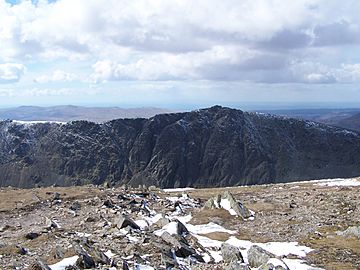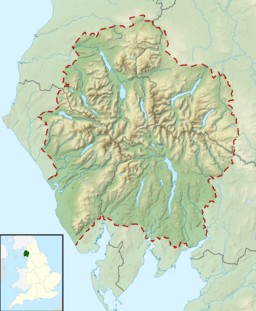Dow Crag facts for kids
Quick facts for kids Dow Crag |
|
|---|---|

Dow Crag from the Old Man of Coniston summit
|
|
| Highest point | |
| Elevation | 778 m (2,552 ft) |
| Prominence | 129 m (423 ft) |
| Parent peak | The Old Man of Coniston |
| Listing | Hewitt, Nuttall, Wainwright |
| Geography | |
| Location | Cumbria, England |
| Parent range | Lake District, Southern Fells |
| OS grid | SD262977 |
| Topo map | OS Landrangers 96, 97, Explorer OL6 |
Dow Crag is a mountain, also called a fell, in the English Lake District. It is located near Coniston, in Cumbria. The eastern side of Dow Crag is a popular spot for rock climbing.
The name Dow Crag originally referred only to its eastern face. This part of the mountain looks down onto a small lake called Goat's Water. Before people started hiking mountains a lot in the 1800s, the whole mountain didn't really need a name. Over time, the name of this famous rock face was used for the entire mountain. "Dow" was once pronounced "Doe," and some local people still say it that way.
Contents
Exploring Dow Crag and Nearby Areas
The Coniston Fells Mountain Range
Dow Crag is part of the Coniston Fells, a chain of mountains in the Lake District. These fells separate Coniston Water from the Duddon Valley. The mountain range starts in the north at Wrynose Pass. It then stretches south for about 16 kilometers (10 miles).
A famous guidebook writer, Alfred Wainwright, included Dow Crag in his book about the Lakeland Fells. This means Dow Crag is one of the 214 "Wainwrights," which are popular peaks for hikers to climb.
How Dow Crag Connects to Other Mountains
The northern part of the Coniston Fells looks a bit like the letter 'Y'. Brim Fell is at the center where the three arms meet. One arm goes north to Swirl How and Great Carrs. Another arm goes southwest to Dow Crag. The third arm goes southeast to The Old Man of Coniston.
Goat's Water, a small lake, sits in a deep valley between Dow Crag and The Old Man of Coniston. A path connects Dow Crag to Brim Fell, crossing a dip called Goat's Hawse, which is above Goat's Water. The path on the Dow Crag side is quite steep and rocky.
The Walna Scar Road
South of Dow Crag, the mountain ridge slopes down. You'll find two smaller peaks here: Buck Pike (744 meters or 2,440 feet) and Brown Pike (682 meters or 2,237 feet). Beyond these, the ridge reaches the Walna Scar Road.
This road is mostly for walkers, but it has also been used by off-road vehicles. This has caused some wear and tear on the path. The Walna Scar Road connects Coniston village to Seathwaite in the Duddon valley. It was built a long time ago for trade and to serve the many slate quarries in these mountains. Parts of the road are paved, but most of it is a stony path.
Lakes Near Dow Crag
Seathwaite Tarn
To the west of Dow Crag, gentle slopes lead down towards the Duddon Valley. Further north on this side is Seathwaite Tarn. This lake is actually a reservoir. It was made much larger in the early 1900s to provide drinking water for the town of Barrow-in-Furness. The dam is nearly 400 meters (400 yards) long and about 24 meters (80 feet) deep.
Goat's Water
Goat's Water is a natural lake, much smaller than Seathwaite Tarn. It's surrounded by steep hills on three sides. This lake is home to both trout and char fish. The water from Goat's Water flows into Torver Beck, a stream that eventually reaches Coniston Water.
Blind Tarn
Another small lake, Blind Tarn, is located to the east of Dow Crag, below Brown Pike. It's called "Blind Tarn" because you can't see any streams flowing into or out of it. It's about 90 meters (100 yards) wide and 6 meters (20 feet) deep. It has a good number of trout, which were likely put there for fishing.
The Summit of Dow Crag
The very top of Dow Crag doesn't have a stone pile (called a cairn). It's a rocky point right above the main rock face. From the summit, you get amazing views south and west towards the coast. However, many other parts of the Lake District are hidden by the nearby Coniston mountains. You can still see the Scafells and the Helvellyn range in the distance.
How to Climb Dow Crag
The easiest ways to reach the summit start from either end of the Walna Scar Road. From there, you can walk to the top of the pass and then to the summit.
For a great view of the famous eastern rock face, you can leave the Walna Scar Road at a spot called The Cove. From there, head towards Goat's Water. Once at Goat's Water, you have two main choices:
- An easier path via Goat's Hawse.
- A steeper path called the South Rake.
Many hikers also reach Dow Crag by following the good paths from The Old Man of Coniston and Brim Fell.
Rock Climbing at Dow Crag
Dow Crag is made of a type of rock called rhyolite. It has a rock face about 100 meters (330 feet) high. There are over 100 known climbing routes here, including:
- Giant's Crawl
- 'C' Ordinary Route
- Hopkinson's Crack
- Eliminate 'A'
- Leopard's Crawl
- Nimrod
- Side Walk
- Holocaust
- Tumble
- The Shining Path
The South Rake is a gully filled with loose rocks (scree) on the southern part of the crag. It's the easiest way to climb the crag, offering a fairly simple scramble, especially for those who are not expert climbers.
Dow Crag is known for being quite cold, windy, and exposed, even in summer. This is typical of the weather in the Cumbrian mountains. Climbers usually get to Dow Crag from the Walna Scar road, which connects the Duddon Valley with Coniston.
You can find more information about climbing at Dow Crag on the UK Climbing crag database.


